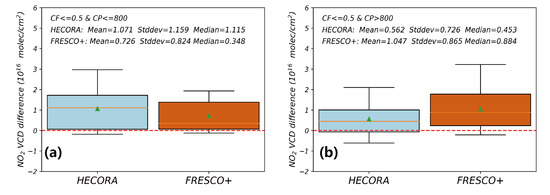Development and Application of HECORA Cloud Retrieval Algorithm Based On the O2-O2 477 nm Absorption Band
Abstract
1. Introduction
2. Algorithm Description
2.1. Look-up Tables
- Input: → reflectance LUT (Equation (1)) → Output: .
- Input: → DOAS fit → Output: ; , where is the continuum reflectance.
- Input: → Equation (4) → Output: .
- All three steps together form the forward LUT: → LUTforward→ .The final objective is to obtain () as a function of () and the rest of the geometric and surface parameters. Exchanging the () and the () columns in the input and the output of LUTforward, we obtain the desired relationship:
- Inverse LUT: () → LUTinverse → ().However, there is still a problem to solve. As defined above, the LUTforward is regular in the input parameters but the output values are scattered in the 2D () plan. Accordingly, LUTinverse has two dimensions () where the nodes are not distributed in a regular grid. In order to define the LUT in a multidimensional (7-dimensional) mesh, the input nodes have to be interpolated. We interpolated the LUTinverse multidimensional scattered data using radial basis functions (RBF) (refer to Veefkind et al., 2016 [15]) leading to the desired inverse LUT in a regular 7-dimensional mesh:
- Inv_regular LUT: LUTinverse () → RBF → LUTinv_regular ().
2.2. Retrieval Algorithm
3. Simulation and Validation of HECORA
3.1. HECORA Results from the Simulated Spectrum
3.2. HECORA Cloud Retrievals from OMI Data
3.3. HECORA Cloud Retrievals from TROPOMI Data
3.3.1. Comparison with Other TROPOMI Cloud Products
3.3.2. Comparison with CALIOP
- (1)
- CALIOP cloud layer is a single layer; cloud optical depth is greater than 4.
- (2)
- For every CALIOP pixel, the collocated TROPOMI pixel we selected is within ±0.025 degrees of the CALIOP latitude and longitude.
- (3)
- HECORA cloud fraction is greater than 0.1.
- (4)
- A local overpass time difference within ±30 min.
- (5)
- CALIOP cloud top pressure and cloud base pressure have been successfully retrieved.
3.3.3. Application to TROPOMI NO2 Retrieval and Comparison with MAX-DOAS
4. Conclusions
5. Discussion
Author Contributions
Funding
Acknowledgments
Conflicts of Interest
Abbreviations
| HECORA | Hefei EMI Cloud Retrieval Algorithm |
| EMI | Environment Monitoring Instrument |
| VLIDORT | The Vector Linearized Discrete Ordinate Radiative Transfer modle |
| TOA | Top of the Atmosphere |
| LUT | Look-up Tables |
| DOAS | Differential Optical Absorption Spectroscopy |
| VCDgeo | geometrical vertical column density |
| OMI | Ozone Monitoring Instrument |
| GOME-2 | Global Ozone Monitoring Experiment-2 |
| MODIS | Moderate Resolution Imaging Spectrometer |
| TROPOMI | Tropospheric Monitoring Instrument |
| CALIOP | Cloud-Aerosol Lidar and Infrared Pathfinder Satellite Observations |
| SCD | slant column density |
| EUMETSAT | European Meteorological Satellite |
| OCRA | Optical Cloud Recognition Algorithm |
| ROCINN | Retrieval of Cloud Information using Neural Networks |
| FRESCO | Fast Retrieval Scheme for Clouds from the Oxygen A-band |
| SIBYL | selective iterative boundary locator |
| SCA | scene classification algorithm |
| HERA | hybrid extinction retrieval algorithm |
| SCIMACHY | Scanning Imaging Absorption spectrometer for Atmospheric Cartography |
| MAX-DOAS | multiaxial differential optical absorption spectroscopy |
| SZA | solar zenith angle |
| IPA | independent pixel approximation |
| VZA | viewing zenith angle |
| RAA | relative azimuth angle |
| SA | surface albedo |
| SP | surface pressure |
| AMF | air-mass factor |
| RT | radiative transfer |
| RBF | radial basis functions |
| SAA | solar azimuth angle |
| VAA | viewing azimuth angle |
| COD | cloud optical depth |
| VCD | vertical column density |
References
- King, M.D.; Platnick, S.; Menzel, W.P.; Ackerman, S.A.; Hubanks, P.A. Spatial and temporal distribution of clouds observed by MODIS onboard the Terra and Aqua satellites. IEEE Trans. Geosci. Remote Sens. 2013, 51, 3826–3852. [Google Scholar] [CrossRef]
- Stammes, P.; Sneep, M.; de Haan, J.F.; Veefkind, J.P.; Wang, P.; Levelt, P.F. Effective cloud fractions from the Ozone Monitoring Instrument: Theoretical framework and validation. J. Geophys. Res. 2008, 113. [Google Scholar] [CrossRef]
- Loyola, D.G.; Gimeno García, S.; Lutz, R.; Argyrouli, A.; Romahn, F.; Spurr, R.J.; Pedergnana, M.; Doicu, A.; Molina García, V.; Schüssler, O. The operational cloud retrieval algorithms from TROPOMI on board Sentinel-5 Precursor. Atmos. Meas. Tech. 2018, 11, 409–427. [Google Scholar] [CrossRef]
- Liu, X.; Newchurch, M.; Loughman, R.; Bhartia, P. Errors resulting from assuming opaque Lambertian clouds in TOMS ozone retrieval. J. Quant. Spectrosc. Radiat. Transf. 2004, 85, 337–365. [Google Scholar] [CrossRef]
- Kokhanovsky, A.; Rozanov, V. The uncertainties of satellite DOAS total ozone retrieval for a cloudy sky. Atmos. Res. 2008, 87, 27–36. [Google Scholar] [CrossRef]
- Wagner, T.; Beirle, S.; Deutschmann, T.; Grzegorski, M.; Platt, U. Dependence of cloud properties derived from spectrally resolved visible satellite observations on surface temperature. Atmos. Chem. Phys. 2008, 8, 2299–2312. [Google Scholar] [CrossRef]
- Levelt, P.F.; van den Oord, G.H.J.; Dobber, M.R.; Malkki, A.; Huib, V.; Johan de, V.; Stammes, P.; Lundell, J.O.V.; Saari, H. The ozone monitoring instrument. IEEE Trans. Geosci. Remote Sens. 2006, 44, 1093–1101. [Google Scholar] [CrossRef]
- Callies, J.; Corpaccioli, E.; Eisinger, M.; Hahne, A.; Lefebvre, A. GOME-2-Metop’s second-generation sensor for operational ozone monitoring. ESA Bull. 2000, 102, 28–36. [Google Scholar]
- Munro, R.; Lang, R.; Klaes, D.; Poli, G.; Retscher, C.; Lindstrot, R.; Huckle, R.; Lacan, A.; Grzegorski, M.; Holdak, A. The GOME-2 instrument on the Metop series of satellites: Instrument design, calibration, and level 1 data processing-an overview. Atmos. Meas. Tech. 2016, 9, 1279–1301. [Google Scholar] [CrossRef]
- Veefkind, J.; Aben, I.; McMullan, K.; Förster, H.; De Vries, J.; Otter, G.; Claas, J.; Eskes, H.; De Haan, J.; Kleipool, Q. TROPOMI on the ESA Sentinel-5 Precursor: A GMES mission for global observations of the atmospheric composition for climate, air quality and ozone layer applications. Remote Sens. Environ. 2012, 120, 70–83. [Google Scholar] [CrossRef]
- Salomonson, V.V.; Barnes, W.; Maymon, P.W.; Montgomery, H.E.; Ostrow, H. MODIS: Advanced facility instrument for studies of the Earth as a system. IEEE Trans. Geosci. Remote Sens. 1989, 27, 145–153. [Google Scholar] [CrossRef]
- Winker, D.M.; Vaughan, M.A.; Omar, A.; Hu, Y.; Powell, K.A.; Liu, Z.; Hunt, W.H.; Young, S.A. Overview of the CALIPSO mission and CALIOP data processing algorithms. J. Atmos. Ocean. Technol. 2009, 26, 2310–2323. [Google Scholar] [CrossRef]
- Yin, H.; Sun, Y.; Liu, C.; Zhang, L.; Lu, X.; Wang, W.; Shan, C.; Hu, Q.; Tian, Y.; Zhang, C. FTIR time series of stratospheric NO 2 over Hefei, China, and comparisons with OMI and GEOS-Chem model data. Opt. Express 2019, 27, A1225–A1240. [Google Scholar] [CrossRef] [PubMed]
- Acarreta, J.; De Haan, J.; Stammes, P. Cloud pressure retrieval using the O2-O2 absorption band at 477 nm. J. Geophys. Res. Atmos. 2004, 109. [Google Scholar] [CrossRef]
- Veefkind, J.P.; de Haan, J.F.; Sneep, M.; Levelt, P.F. Improvements to the OMI O2–O2 operational cloud algorithm and comparisons with ground-based radar–lidar observations. Atmos. Meas. Tech. 2016, 9, 6035–6049. [Google Scholar] [CrossRef]
- Koelemeijer, R.; Stammes, P.; Hovenier, J.; De Haan, J. A fast method for retrieval of cloud parameters using oxygen A band measurements from the Global Ozone Monitoring Experiment. J. Geophys. Res. Atmos. 2001, 106, 3475–3490. [Google Scholar] [CrossRef]
- R, D.G.L.; Thomas, W.; Spurr, R.; Mayer, B. Global patterns in daytime cloud properties derived from GOME backscatter UV-VIS measurements. Int. J. Remote Sens. 2010, 31, 4295–4318. [Google Scholar]
- Rodriguez, D.G.L.; Thomas, W.; Livschitz, Y.; Ruppert, T.; Albert, P.; Hollmann, R. Cloud Properties Derived From GOME/ERS-2 Backscatter Data for Trace Gas Retrieval. IEEE Trans. Geosci. Remote Sens. 2007, 45, 2747–2758. [Google Scholar] [CrossRef]
- Wang, P.; Tuinder, O.; Stammes, P. Cloud retrieval algorithm for GOME-2: FRESCO+. Available online: http://www.temis.nl/docs/AD_FRESCO.pdf (accessed on 15 September 2020).
- Wang, P.; Stammes, P.; Pinardi, G.; Van Roozendael, M. FRESCO+: An improved O 2 A-band cloud retrieval algorithm for tropospheric trace gas retrievals. Atmos. Chem. Phys. 2008, 8, 6565–6576. [Google Scholar] [CrossRef]
- Platnick, S.; King, M.D.; Ackerman, S.A.; Menzel, W.P.; Baum, B.A.; Riedi, J.C.; Frey, R.A. The MODIS cloud products: Algorithms and examples from terra. IEEE Trans. Geosci. Remote Sens. 2003, 41, 459–473. [Google Scholar] [CrossRef]
- Kleipool, Q.; Ludewig, A.; Babić, L.; Bartstra, R.; Braak, R.; Dierssen, W.; Dewitte, P.-J.; Kenter, P.; Landzaat, R.; Leloux, J. Pre-launch calibration results of the TROPOMI payload on-board the Sentinel-5 Precursor satellite. Atmos. Meas. Tech. 2018, 11, 6439–6479. [Google Scholar] [CrossRef]
- Vasilkov, A.; Yang, E.-S.; Marchenko, S.; Qin, W.; Lamsal, L.; Joiner, J.; Krotkov, N.; Haffner, D.; Bhartia, P.K.; Spurr, R. A cloud algorithm based on the O2-O2 477 nm absorption band featuring an advanced spectral fitting method and the use of surface geometry-dependent Lambertian-equivalent reflectivity. Atmos. Meas. Tech. 2018, 11, 4093–4107. [Google Scholar] [CrossRef]
- Deschamps, P.; Fouquart, Y.; Tanré, D.; Herman, M.; Lenoble, J.; Buriez, J.; Dubuisson, P.; Parol, F.; Vanbauce, C.; Grassl, H. Study on the Effects of Scattering on the Monitoring of Atmospheric Constituents. Rep. 3838, ESA Contract No. 9740/91/NL/BI. 1994. Available online: https://scholar.google.com/scholar?lookup=0&q=Study+on+the+effects+of+scattering+on+the+monitoring+of+atmospheric+constituents.+Rep.+3838,+ESA+contract+no.+9740/91/NL/BI%3B+1994.&hl=en&as_sdt=0,5 (accessed on 3 August 2020).
- Zhang, C.; Liu, C.; Chan, K.L.; Hu, Q.; Liu, H.; Li, B.; Xing, C.; Tan, W.; Zhou, H.; Si, F. First observation of tropospheric nitrogen dioxide from the Environmental Trace Gases Monitoring Instrument onboard the GaoFen-5 satellite. Light Sci. Appl. 2020, 9, 1–9. [Google Scholar] [CrossRef] [PubMed]
- Zhang, C.; Liu, C.; Wang, Y.; Si, F.; Zhou, H.; Zhao, M.; Su, W.; Zhang, W.; Chan, K.L.; Liu, X. Preflight evaluation of the performance of the Chinese environmental trace gas monitoring instrument (EMI) by spectral analyses of nitrogen dioxide. IEEE Trans. Geosci. Remote Sens. 2018, 56, 3323–3332. [Google Scholar] [CrossRef]
- Spurr, R.J. VLIDORT: A linearized pseudo-spherical vector discrete ordinate radiative transfer code for forward model and retrieval studies in multilayer multiple scattering media. J. Quant. Spectrosc. Radiat. Transf. 2006, 102, 316–342. [Google Scholar] [CrossRef]
- Cahalan, R.F.; Ridgway, W.; Wiscombe, W.J.; Bell, T.L.; Snider, J.B. The albedo of fractal stratocumulus clouds. J. Atmos. Sci. 1994, 51, 2434–2455. [Google Scholar] [CrossRef]
- Zuidema, P.; Evans, K.F. On the validity of the independent pixel approximation for boundary layer clouds observed during ASTEX. J. Geophys. Res. Atmos. 1998, 103, 6059–6074. [Google Scholar] [CrossRef]
- Plat, U. Differential Optical Absorption Spectroscopy. Air Monitoring by Spectroscopic Techniques; Chemical Analysis Series; John Wiley & Sons: Hoboken, NJ, USA, 1994; Volume 127, pp. 27–84. [Google Scholar]
- Perner, D.; Ehhalt, D.; Pätz, H.; Platt, U.; Röth, E.; Volz, A. OH-radicals in the lower troposphere. Geophys. Res. Lett. 1976, 3, 466–468. [Google Scholar] [CrossRef]
- Platt, U.; Perner, D.; Pätz, H. Simultaneous measurement of atmospheric CH2O, O3, and NO2 by differential optical absorption. J. Geophys. Res. Ocean. 1979, 84, 6329–6335. [Google Scholar] [CrossRef]
- Danckaert, T.; Fayt, C.; Van Roozendael, M.; De Smedt, I.; Letocart, V.; Merlaud, A.; Pinardi, G. QDOAS Software User Manual. 2012. Available online: http://uv-vis.aeronomie.be/software/QDOAS/QDOAS_manual.pdf (accessed on 15 September 2020).
- Vandaele, A.C.; Hermans, C.; Simon, P.C.; Carleer, M.; Colin, R.; Fally, S.; Merienne, M.-F.; Jenouvrier, A.; Coquart, B. Measurements of the NO2 absorption cross-section from 42,000 cm−1 to 10,000 cm−1 (238–1000 nm) at 220 K and 294 K. J. Quant. Spectrosc. Radiat. Transf. 1998, 59, 171–184. [Google Scholar] [CrossRef]
- Brion, J.; Chakir, A.; Charbonnier, J.; Daumont, D.; Parisse, C.; Malicet, J. Absorption spectra measurements for the ozone molecule in the 350–830 nm region. J. Atmos. Chem. 1998, 30, 291–299. [Google Scholar] [CrossRef]
- Thalman, R.; Volkamer, R. Temperature dependent absorption cross-sections of O 2–O 2 collision pairs between 340 and 630 nm and at atmospherically relevant pressure. Phys. Chem. Chem. Phys. 2013, 15, 15371–15381. [Google Scholar] [CrossRef] [PubMed]
- Chance, K.V.; Spurr, R.J. Ring effect studies: Rayleigh scattering, including molecular parameters for rotational Raman scattering, and the Fraunhofer spectrum. Appl. Opt. 1997, 36, 5224–5230. [Google Scholar] [CrossRef] [PubMed]
- Danielson, J.J.; Gesch, D.B. Global Multi-Resolution Terrain Elevation Data 2010 (GMTED2010); US Department of the Interior, US Geological Survey: SanDiego, CA, USA, 2011.
- Tilstra, L.; Tuinder, O.; Wang, P.; Stammes, P. Surface reflectivity climatologies from UV to NIR determined from Earth observations by GOME-2 and SCIAMACHY. J. Geophys. Res. Atmos. 2017, 122, 4084–4111. [Google Scholar] [CrossRef]
- Hale, G.M.; Querry, M.R. Optical constants of water in the 200-nm to 200-μm wavelength region. Appl. Opt. 1973, 12, 555–563. [Google Scholar] [CrossRef]
- Van Geffen, J.; Boersma, K.; Eskes, H.; Maasakkers, J.; Veefkind, J. TROPOMI ATBD of the Total and Tropospheric NO2 Data Products; DLR Document. 2014. Available online: https://sentinel.esa.int/documents/247904/2476257/Sentinel-5P-TROPOMI-ATBD-NO2-data-products (accessed on 15 September 2020).
- Zhang, C.; Liu, C.; Hu, Q.; Cai, Z.; Su, W.; Xia, C.; Zhu, Y.; Wang, S.; Liu, J. Satellite UV-Vis spectroscopy: Implications for air quality trends and their driving forces in China during 2005–2017. Light Sci. Appl. 2019, 8, 100. [Google Scholar] [CrossRef]
- Beirle, S.; Hörmann, C.; Jöckel, P.; Liu, S.; Penning de Vries, M.; Pozzer, A.; Sihler, H.; Valks, P.; Wagner, T. The STRatospheric Estimation Algorithm from Mainz (STREAM): Estimating stratospheric NO2 from nadir-viewing satellites by weighted convolution. Atmos. Meas. Tech. (AMT) 2016, 9, 2753–2779. [Google Scholar] [CrossRef]
- Xing, C.; Liu, C.; Wang, S.; Chan, K.; Gao, Y.; Huang, X.; Su, W.; Zhang, C.; Dong, Y.; Fan, G. Observations of the summertime atmospheric pollutants vertical distributions and the corresponding ozone production in Shanghai, China. Atmos. Chem. Phys. Discuss 2017, 2017, 1–31. [Google Scholar] [CrossRef]
- Chan, K.L.; Wiegner, M.; van Geffen, J.; De Smedt, I.; Alberti, C.; Cheng, Z.; Ye, S.; Wenig, M. MAX-DOAS measurements of tropospheric NO2 and HCHO in Munich and the comparison to OMI and TROPOMI satellite observations. Atmos. Meas. Tech. 2020, 13, 4499–4520. [Google Scholar] [CrossRef]
- Cotton, W.R.; Bryan, G.; Van den Heever, S.C. Storm and Cloud Dynamics; Academic Press: Salt Lake City, UT, USA, 2010. [Google Scholar]
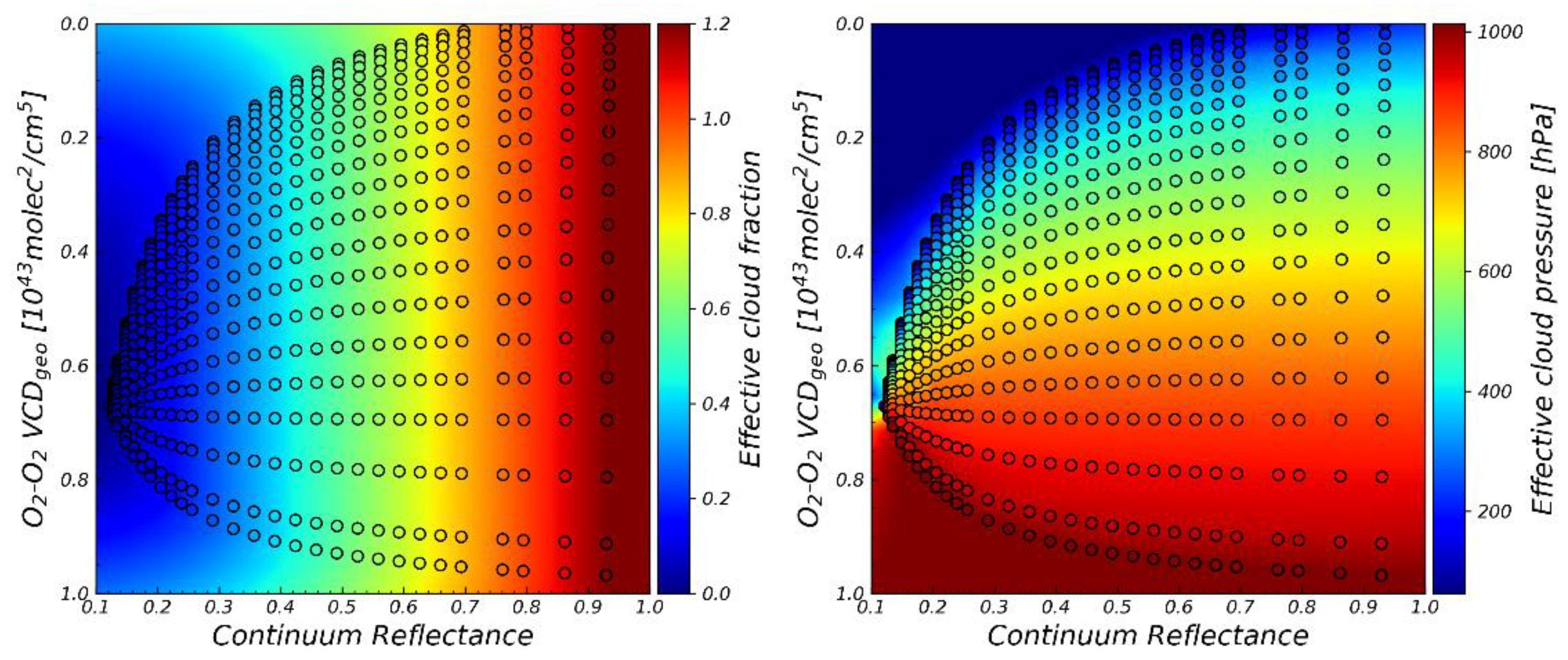
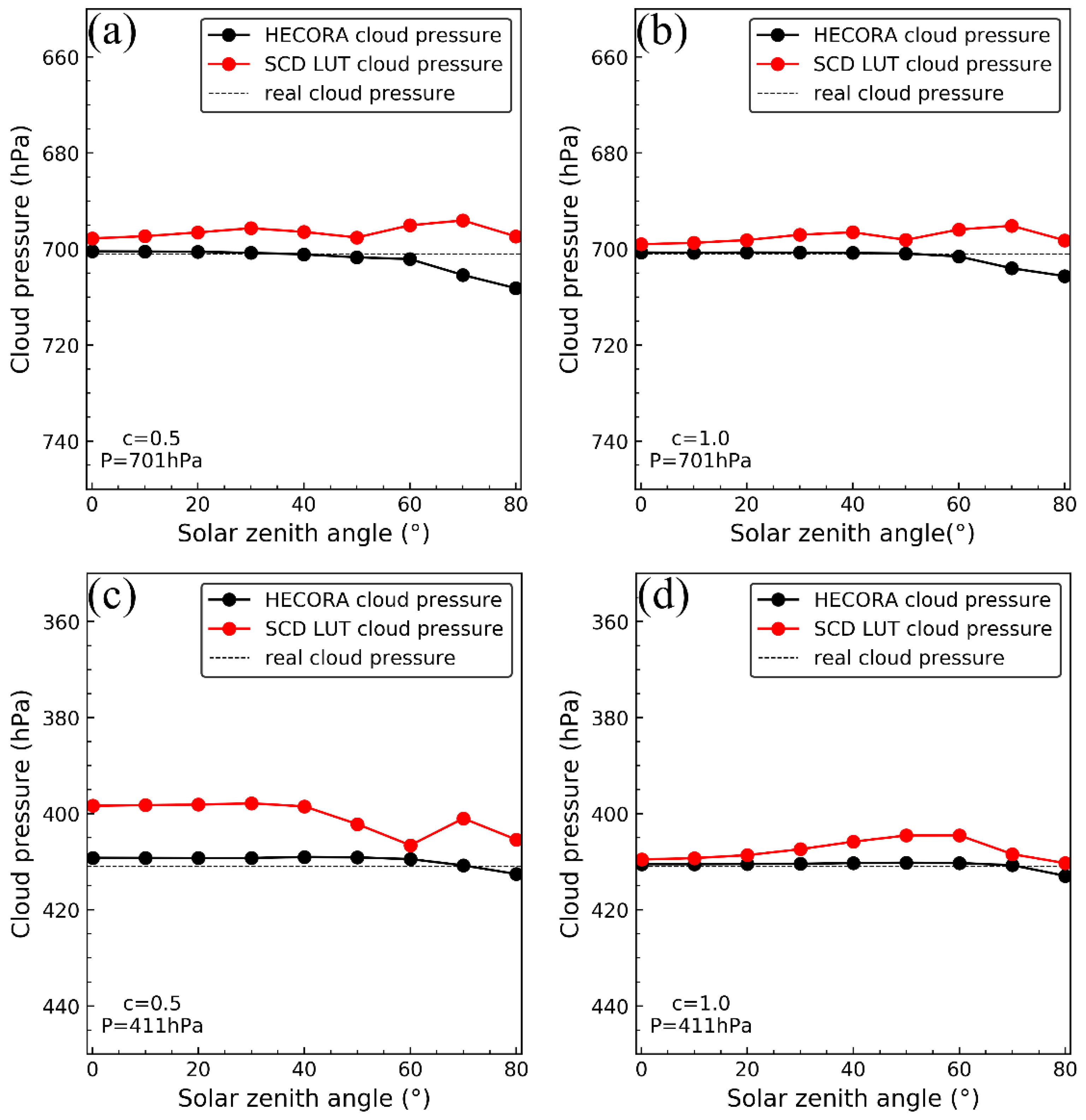
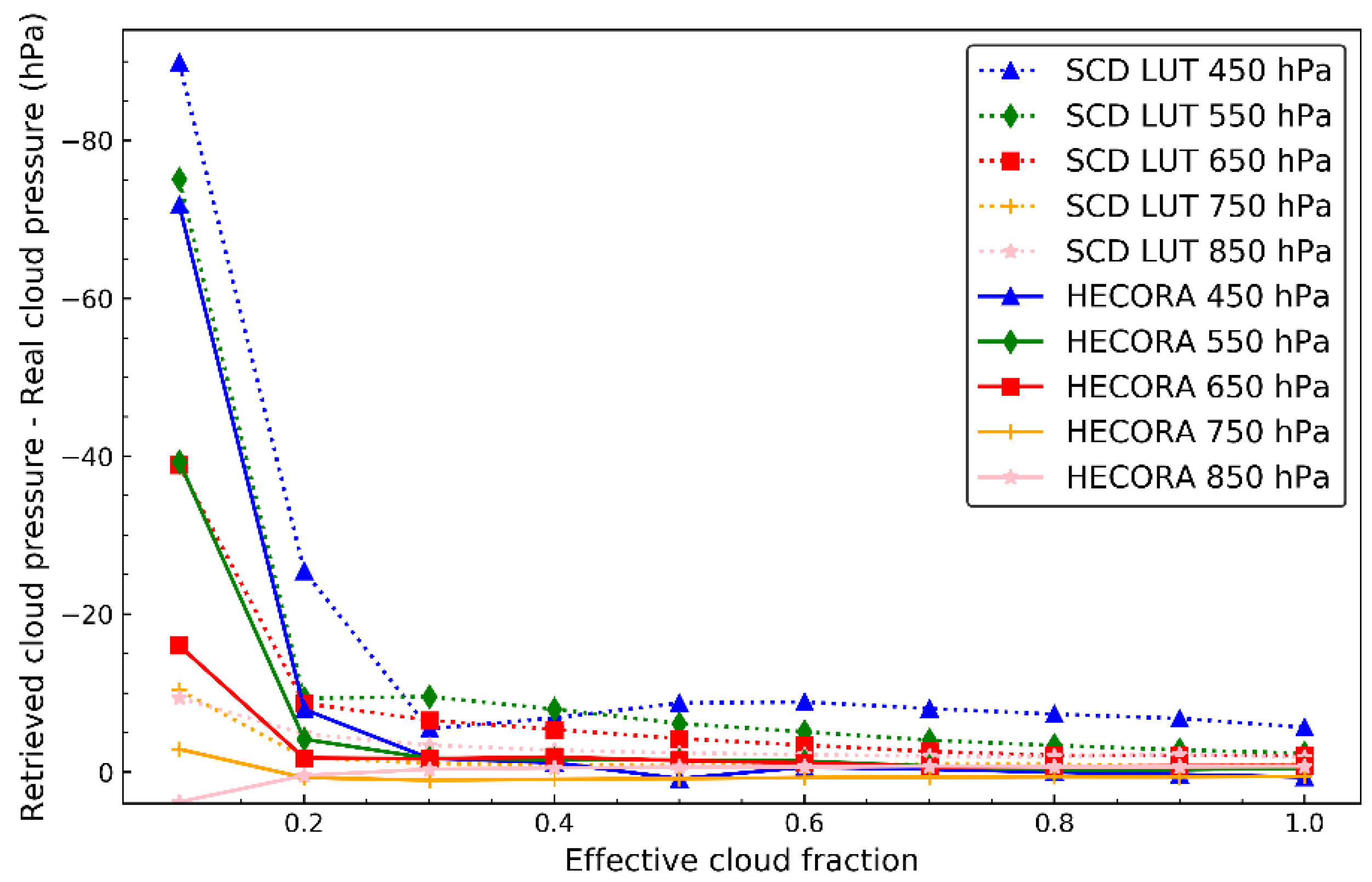
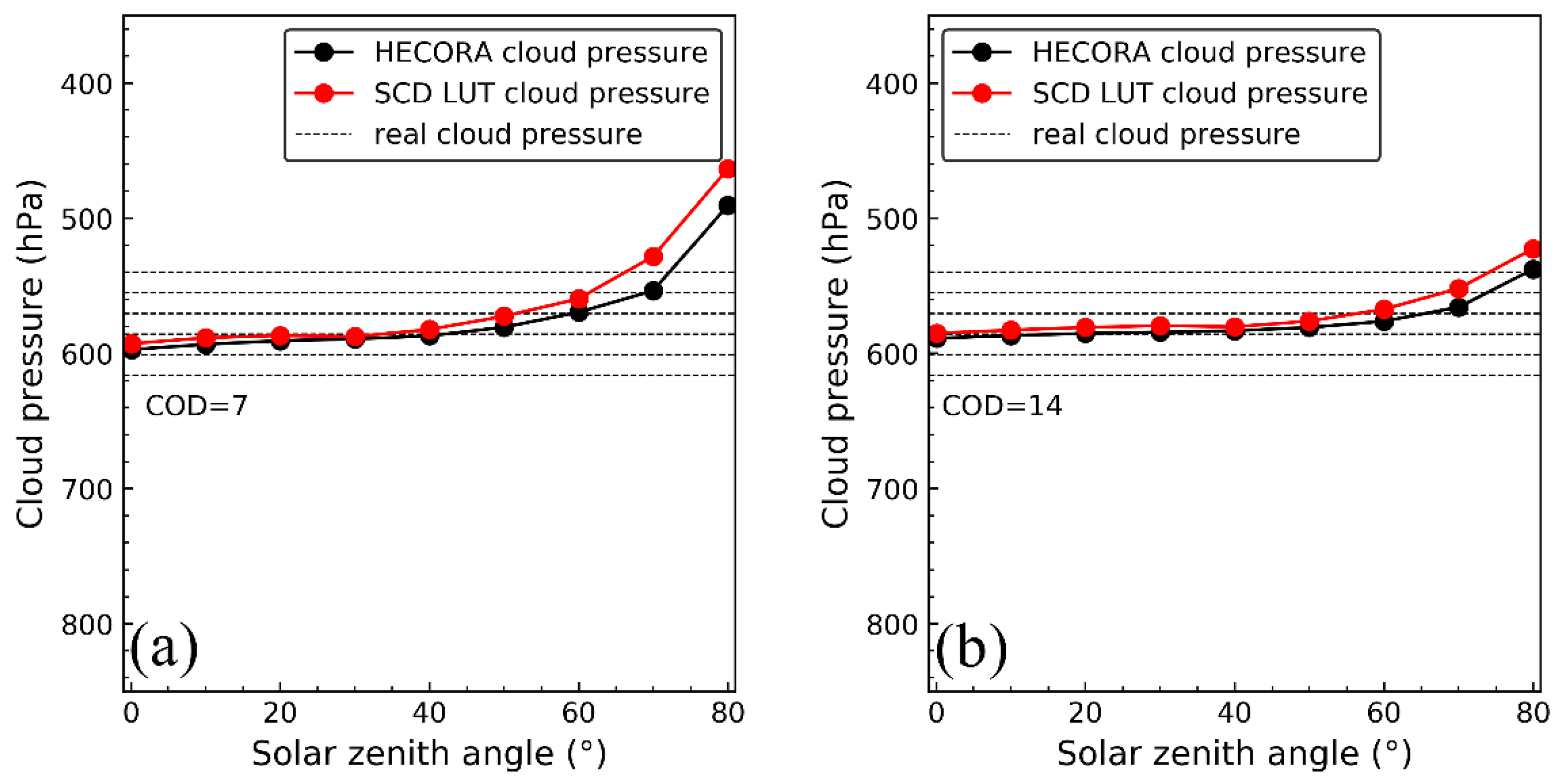
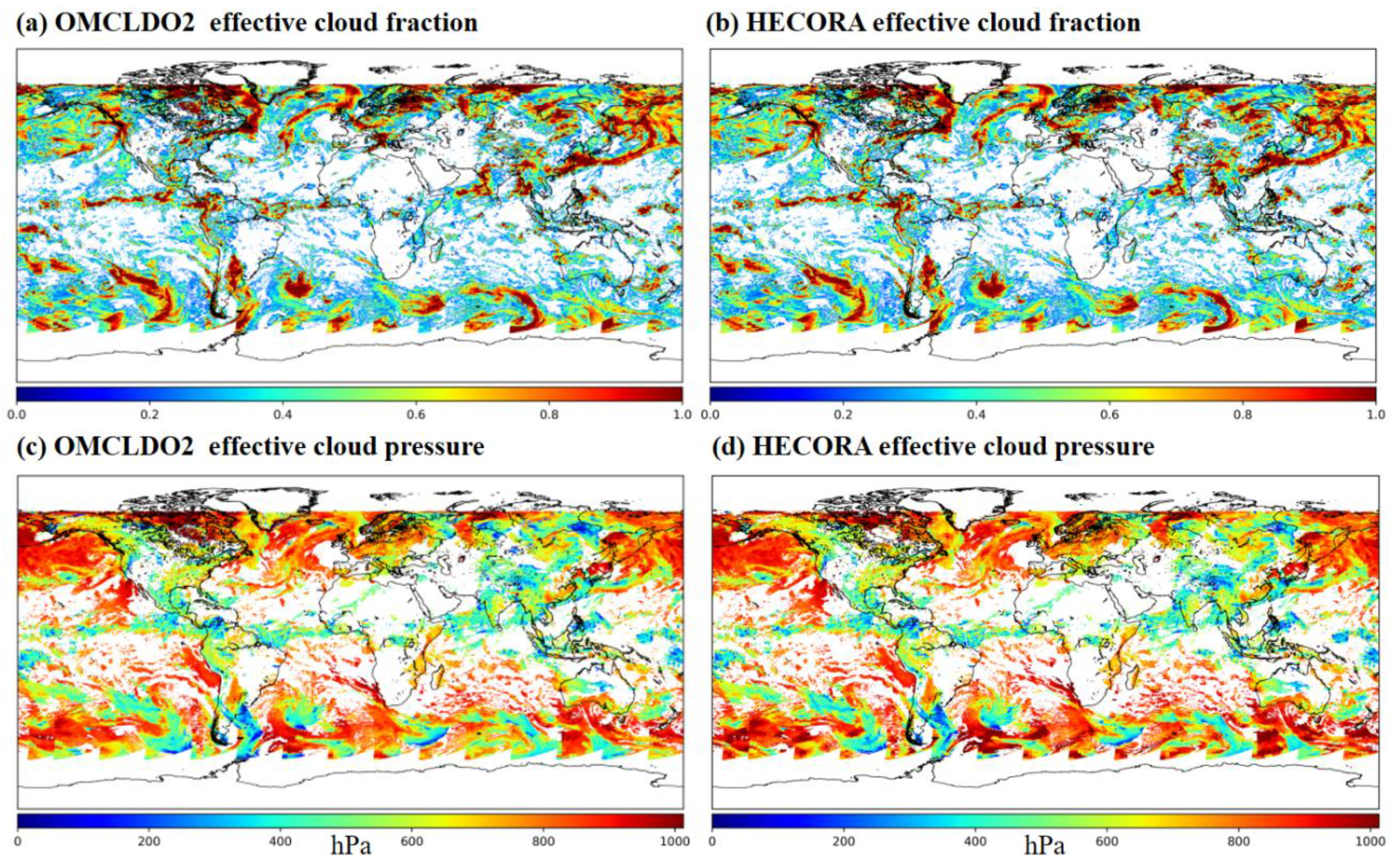




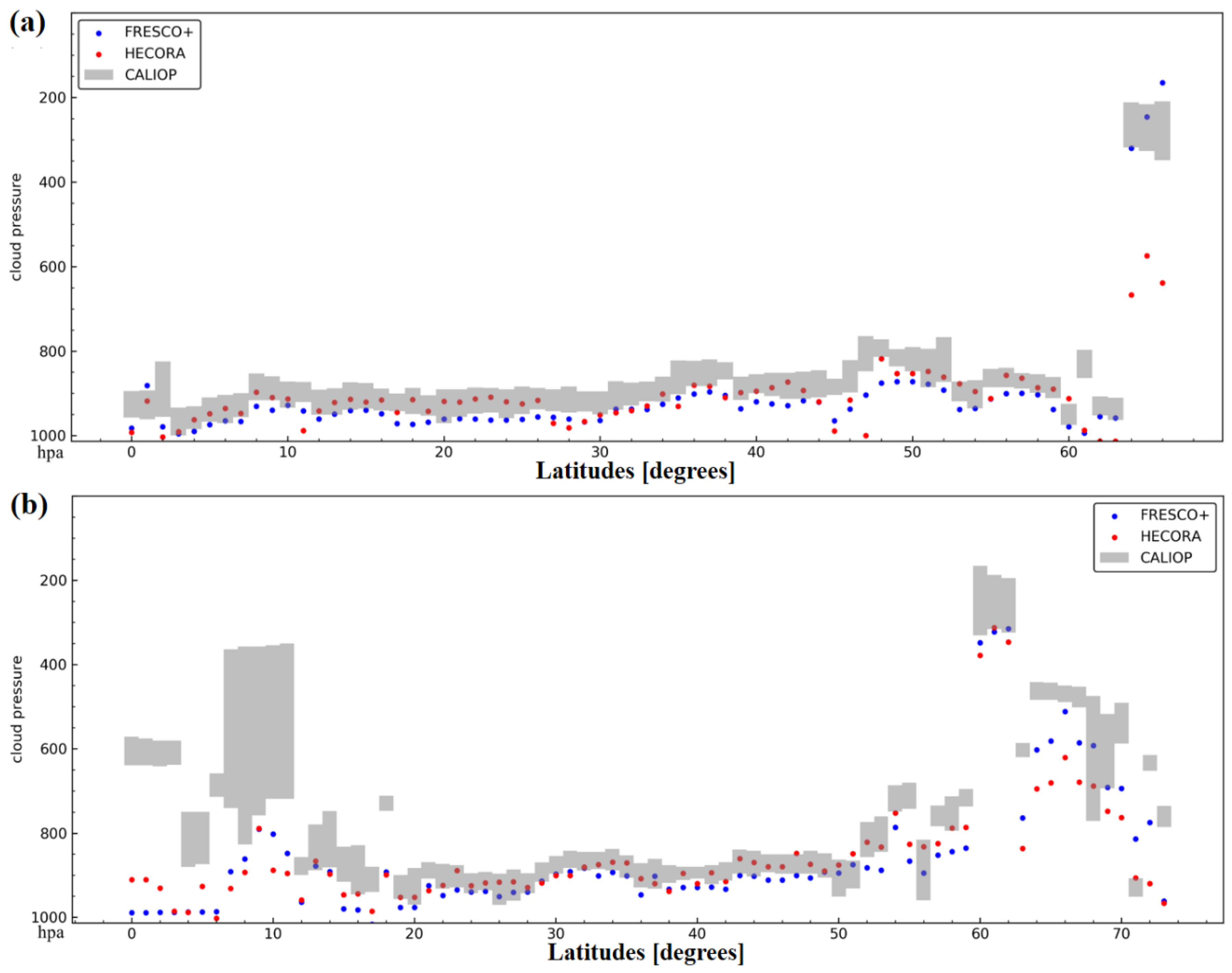
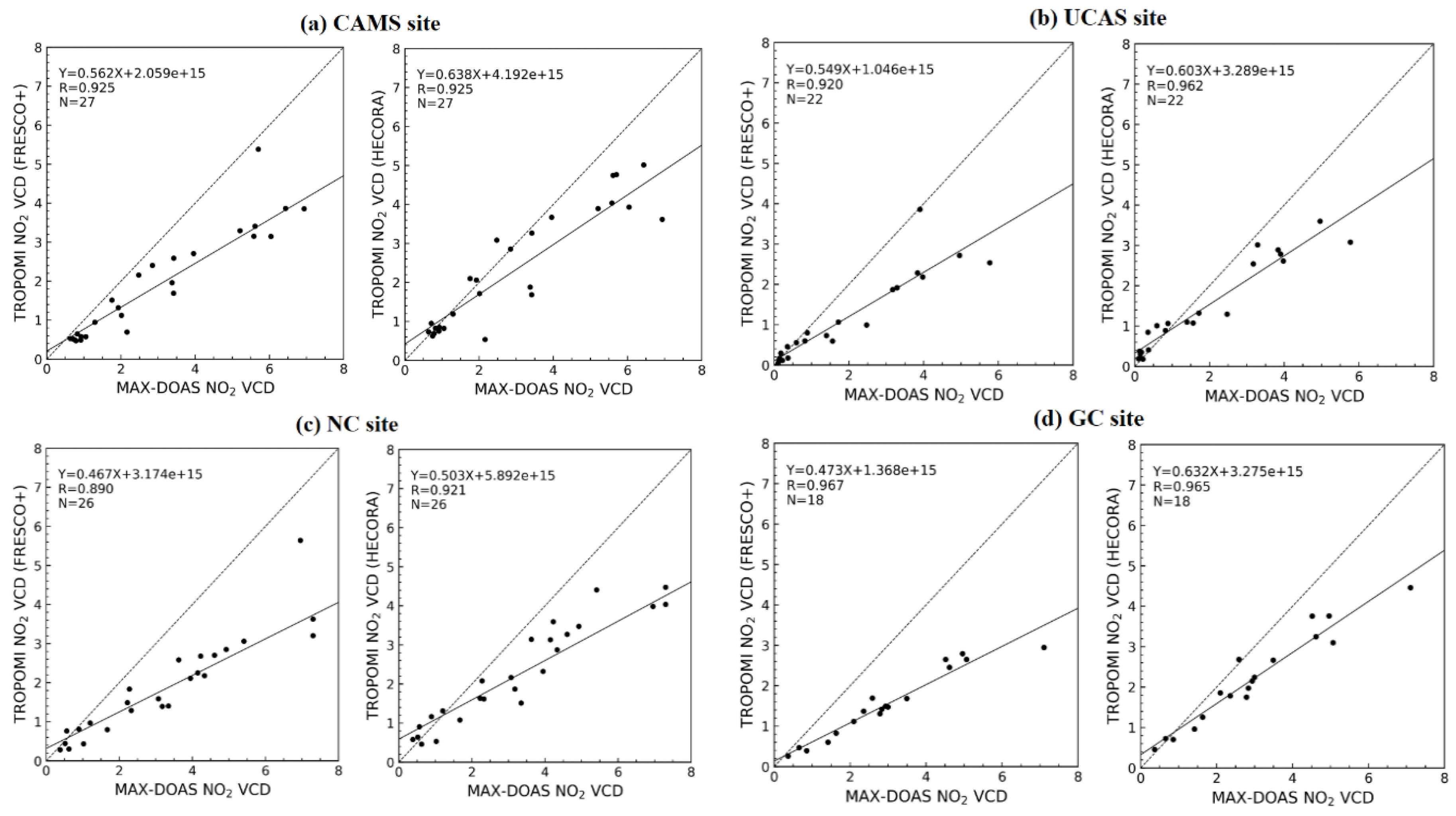
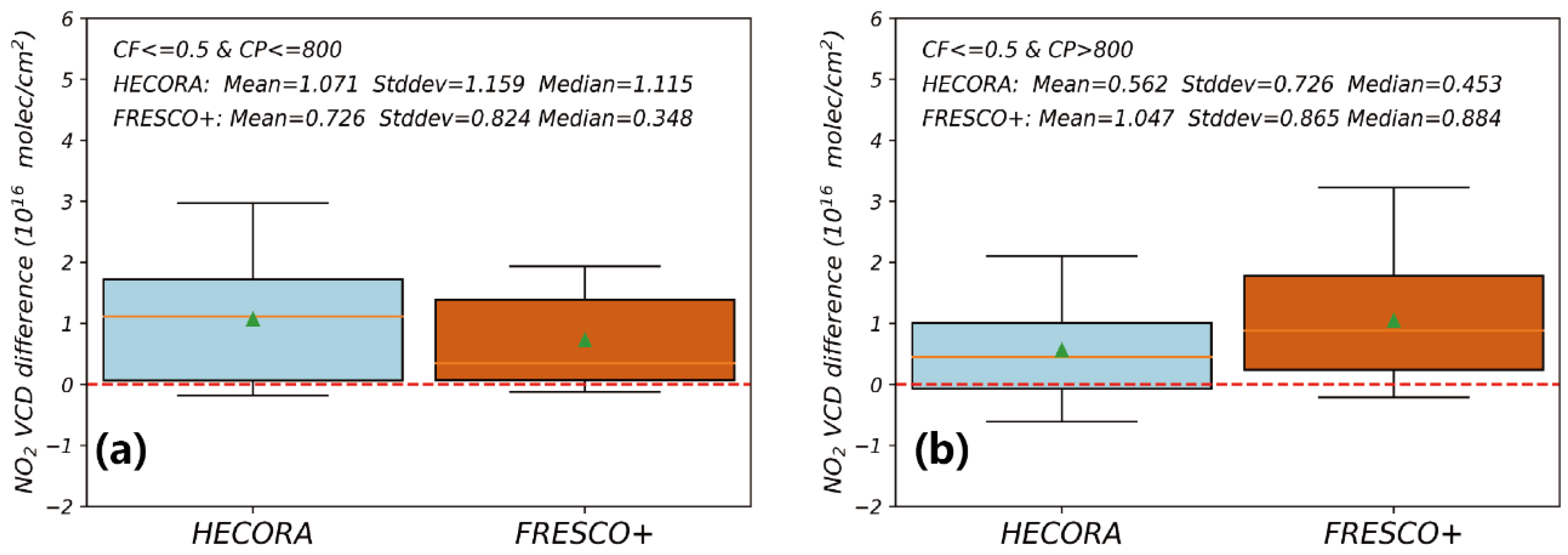
| Parameters | Nodes |
|---|---|
| O2-O2 SCD (OMCLDO2) [] | 0, 0.05, 0.10, 0.15, 0.20, 0.25, 0.30, 0.35, 0.40, 0.45, 0.50, 0.55, 0.60, 0.65, 0.70, 0.75, 0.80, 0.85, 0.90, 0.95, 1.00, 1.10, 1.20 |
| O2-O2 VCDgeo (HECORA) [] | 0, 0.10, 0.20, 0.30, 0.40, 0.50, 0.60, 0.70, 0.80, 0.90, 1.00, 1.10, 1.20, 1.30, 1.40, 1.50, 1.60, 1.70, 1.80, 1.90, 2.00, 2.20, 2.40 |
| Parameters | Resources | Fitting Window/nm |
|---|---|---|
| 460–490 nm (O2-O2) | ||
| NO2 | Vandaele et al. (1998) [34] 240 K | X |
| O3 | Brion et al. (1998) [35] 228 K, 243 K | X |
| O2-O2 | Thalman et al. (2013) [36] 293 K | X |
| Ring | Chance et al. (1997) [37] | X |
| Polynomial order | 1 |
| Number of Cases | Cloud Fraction | Difference | ||||
|---|---|---|---|---|---|---|
| HECORA | FRESCO+ | OCRA | HECORA-FRESCO+ | HECORA- OCRA | ||
| All cases | 281961581 | |||||
| Ocean | 271401746 | |||||
| Land | 4677916 | |||||
| Vegetation | 5881919 | |||||
| Number of Cases | Cloud Pressure (hPa) | Difference (hPa) | ||||
|---|---|---|---|---|---|---|
| HECORA | FRESCO+ | ROCINN | HECORA -FRESCO+ | HECORA -ROCINN | ||
| All cases | 281961581 | |||||
| Ocean | 271401746 | |||||
| Land | 4677916 | |||||
| Vegetation | 5881919 | |||||
| Number of Cases | Cloud Pressure (hPa) | |||
|---|---|---|---|---|
| HECORA | FRESCO+ | CALIOP | ||
| All cases | 11,230 | |||
| Ocean | 10,810 | |||
| Land | 203 | |||
| Vegetation | 217 | |||
© 2020 by the authors. Licensee MDPI, Basel, Switzerland. This article is an open access article distributed under the terms and conditions of the Creative Commons Attribution (CC BY) license (http://creativecommons.org/licenses/by/4.0/).
Share and Cite
Wang, S.; Liu, C.; Zhang, W.; Hao, N.; Gimeno García, S.; Xing, C.; Zhang, C.; Su, W.; Liu, J. Development and Application of HECORA Cloud Retrieval Algorithm Based On the O2-O2 477 nm Absorption Band. Remote Sens. 2020, 12, 3039. https://doi.org/10.3390/rs12183039
Wang S, Liu C, Zhang W, Hao N, Gimeno García S, Xing C, Zhang C, Su W, Liu J. Development and Application of HECORA Cloud Retrieval Algorithm Based On the O2-O2 477 nm Absorption Band. Remote Sensing. 2020; 12(18):3039. https://doi.org/10.3390/rs12183039
Chicago/Turabian StyleWang, Shuntian, Cheng Liu, Wenqiang Zhang, Nan Hao, Sebastián Gimeno García, Chengzhi Xing, Chengxin Zhang, Wenjing Su, and Jianguo Liu. 2020. "Development and Application of HECORA Cloud Retrieval Algorithm Based On the O2-O2 477 nm Absorption Band" Remote Sensing 12, no. 18: 3039. https://doi.org/10.3390/rs12183039
APA StyleWang, S., Liu, C., Zhang, W., Hao, N., Gimeno García, S., Xing, C., Zhang, C., Su, W., & Liu, J. (2020). Development and Application of HECORA Cloud Retrieval Algorithm Based On the O2-O2 477 nm Absorption Band. Remote Sensing, 12(18), 3039. https://doi.org/10.3390/rs12183039








